[PICS] Canadian Maritime Air Museum Tour, Aug. 11-16, 2008
Sun Aug 17, 2008 5:12 pm
This past week I had a few days of business meetings in St. Andrews, NB, and decided to bring my car and cameras and "do" the region, air museum wise. So without further ado I present:
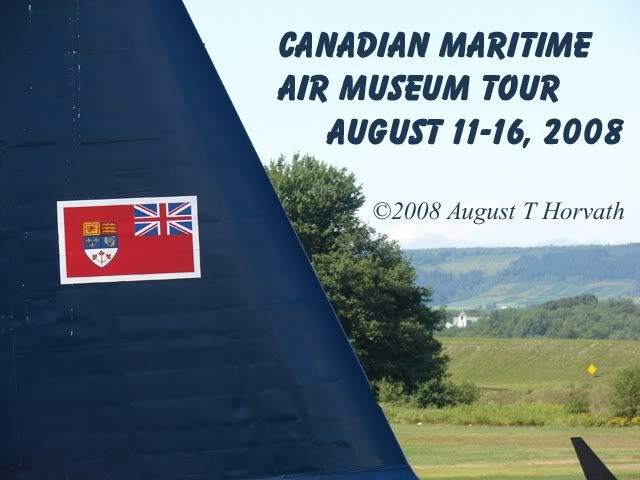
I decided to start by seeing one of the world's least-seen Avro Lancasters, Mk.10AR KB882 at Edmundston, NB. I drove direct from my house in a New York City suburb to Edmundston, a trip of some 660 miles, which took about 11 hours. Arriving around 8:00 local time, I then had to wait another hour for a thunderstorm to subside, and finally got to take some pics in the waning light.
Edmundston is a reasonably picturesque but foul-smelling logging and sawmill town very close to the border between New Brunswick and Quebec. It is served by a tiny one-runway airport that straddles the NB and Quebec border. The small building below serves the combined function of control "tower", passenger terminal, weather station, and all other administrative duties. It was unoccupied. In fact there was not another living soul on the airport, unless the geese who were enjoying the use of the runway have souls.
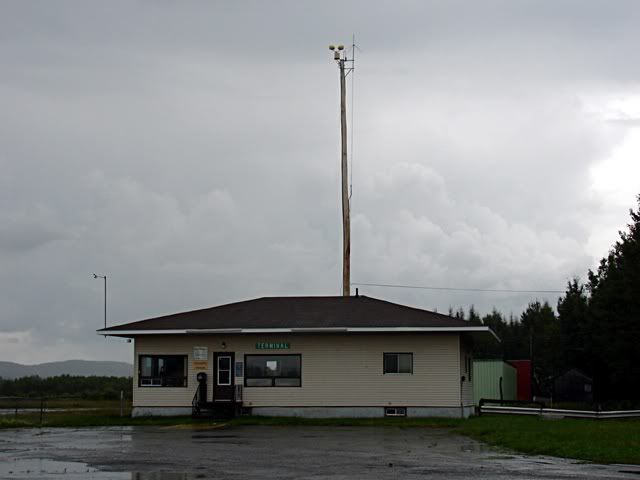
The few hangars were buttoned up tight and there were no other aircraft outside. KB882 sits in a clearing next to the administrative building next to a nice picnic area which would be a pleasant place to watch the air traffic if there were any. The aircraft itself is located barely on the NB side, about two wingspans from the "Bienvenue au Quebec" sign, next to a little stand of trees and with mountains in the background, quite nice really. Although the location is remote, both Trans Canada Highway 2 and the Trans Canada trail (a continuous 14,500-km hiking/biking trail that meanders through every Canadian province) are just meters away, so it does get seen by those with a wandering bent. One other tourist in an RV stopped to have a look while I was there.
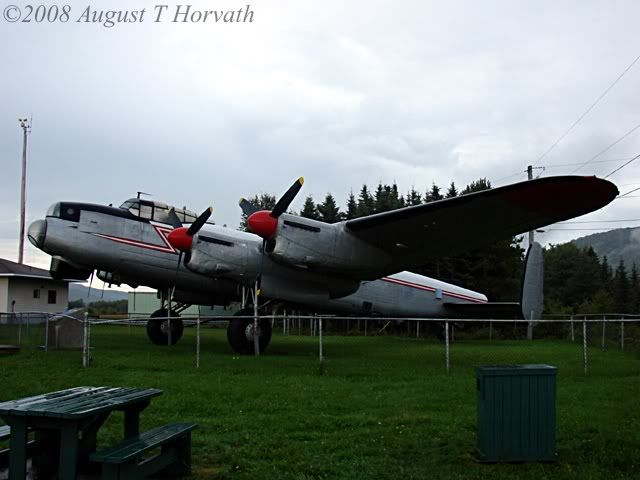
The aircraft is surrounded by a chain link fence, but at only 4 feet high, it is easy to shoot over. Better yet, it has a gate which is not locked, so close-up inspection of the aircraft is possible. Despite the easy access and lack of supervision, there was no evidence of vandalism to the aircraft. Somebody obviously takes very good care of the aircraft.
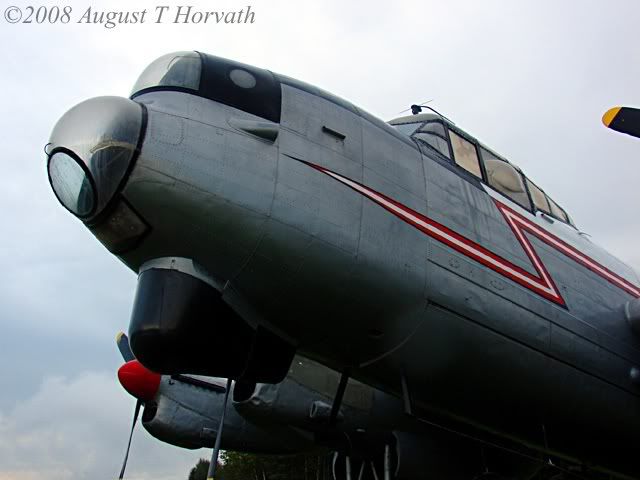
KB882 is a bona fide veteran which, according to the placard, completed 15 ops over enemy territory with 428 Sqn RCAF. Returned to Canada for patrol duties, it was converted to 10AR photo recon configuration, which involved lengthening the nose by inserting a section forward of the windscreen and by installing an array of sensors and cameras. It was retired to this airport in 1964 and has been on outside display ever since.
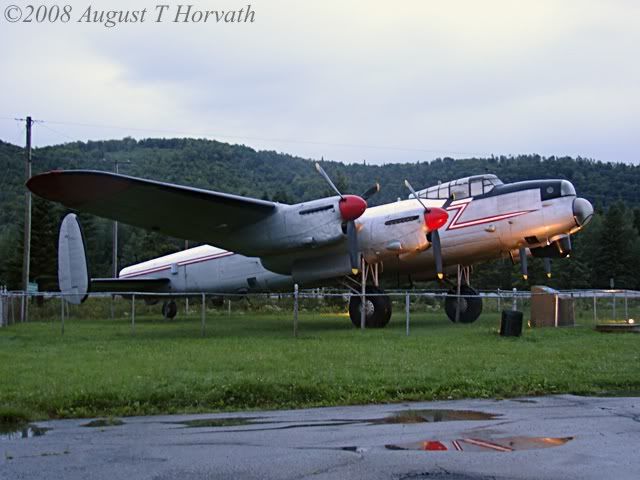
Despite the long storage outside, the aircraft is in excellent condition, with good paint and very little evidence of corrosion. It has been preserved in stock 10AR configuration, with external and (so far as can be seen) internal equipment intact. It wears a generally accurate 1960s RCAF paint scheme but, oddly, no markings. Automatic spotlights illuminate the machine at night.
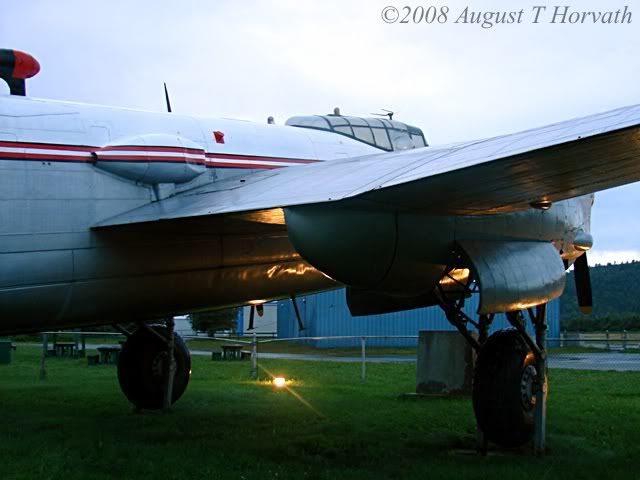
After looking around the aircraft I sought out the nearest place of lodging which appeared to have a decent restaurant attached, that being the Quality Inn Edmundston. I recommend this fine establishment if somehow you find yourself touring the area. The friendly bar clearly is popular with the locals, due no doubt to the excellent potato skins, regional beer, and my waitress, Frederique. In the morning I returned to the aircraft for a few dawn shots before proceeding to my business meetings on the coast.
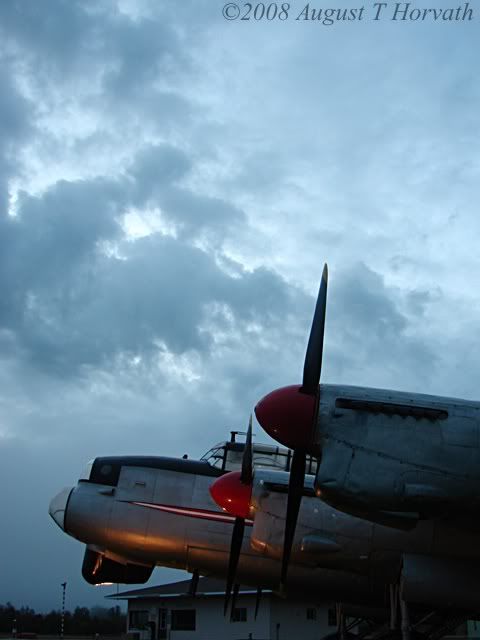
The story picks up three days later when I set out to cover the Nova Scotia museums. The first and most easily reached is the Atlantic Canada Aviation Museum, which is located near the Halifax airport well outside of the city of Halifax on TCH-2. The premises are shared by a general purpose tourist information center, which must be useful for drawing a few incremental visitors to the museum.
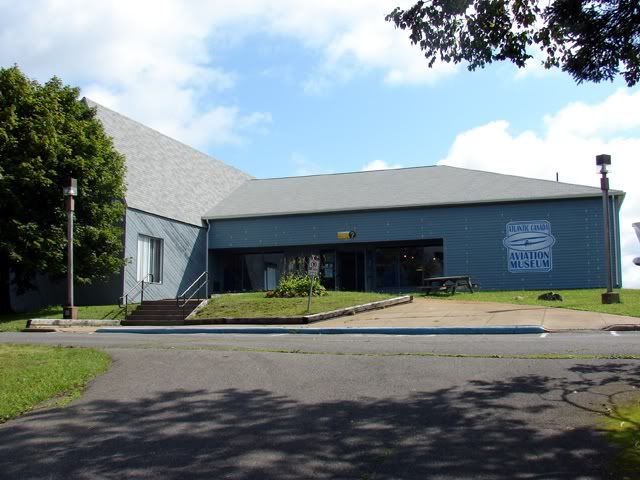
Guarding the outside of the museum is CF-101 101043, which received a special paint scheme as "Lynx One" on the occasion of Voodoo retirement with 419 Sqn. Although repainted in 1999-2000, according to the museum's web site, it apparently is now being repainted again.
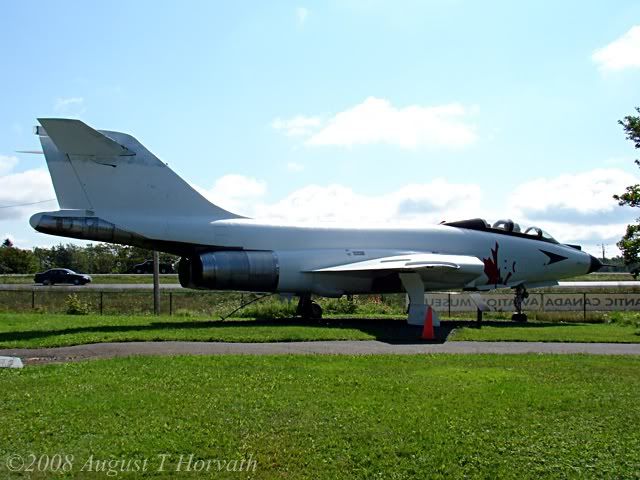
Inside, the exhibit space is crowded. Here, CF-104 104783 shares space with a Silver Dart replica, some helicopters, and assorted displays.
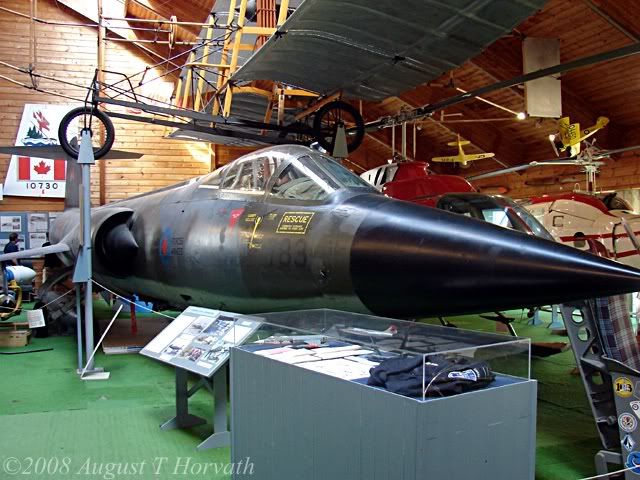
The main exhibit building is literally jam-packed with many interesting aircraft. Here, a Sabre Mk.V rests near CF-100 18747. The museum has a collection of RCAF/CAF jet fighters that is complete except for the early Vampire and the still-in-service CF-18.
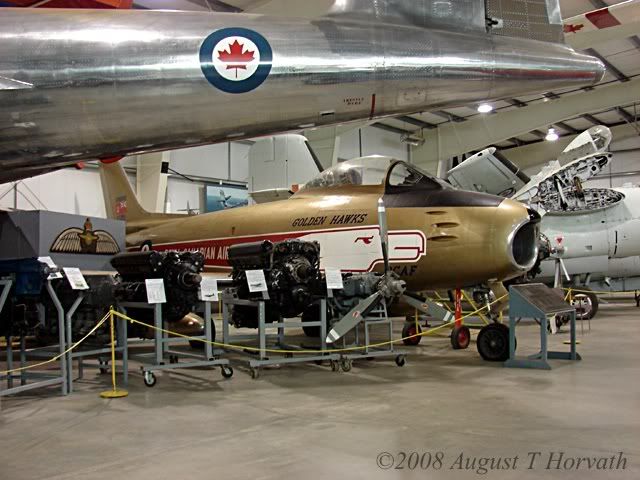
T-33 133174 is displayed with wings off, there being no space to display the complete airplane.
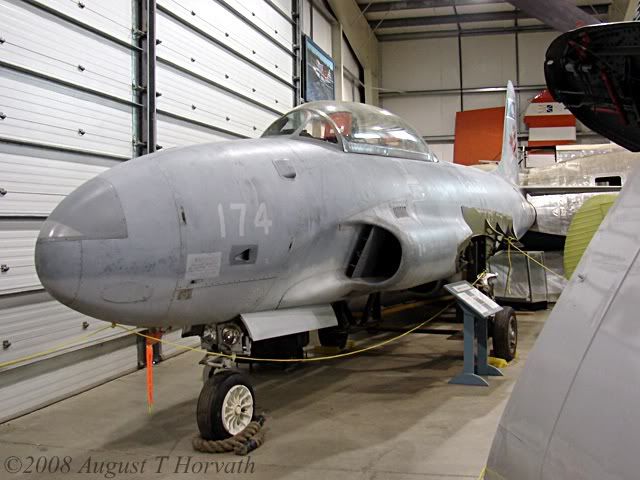
Canadair Argus nose section.
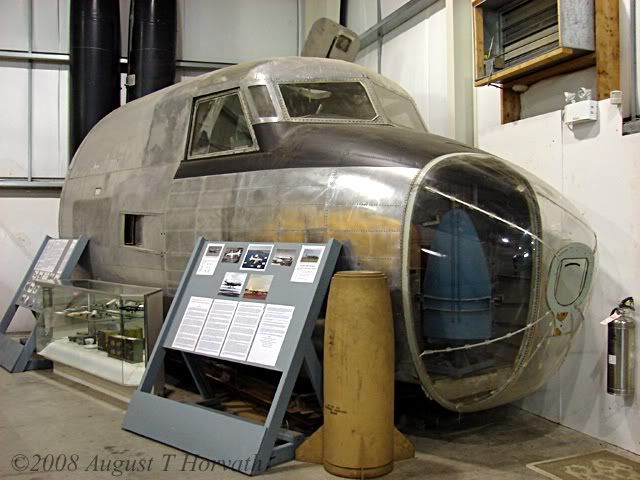
L-19 Bird Dog project, ex US Army 56-4037 and RCAF 16720, with Canso project in background.
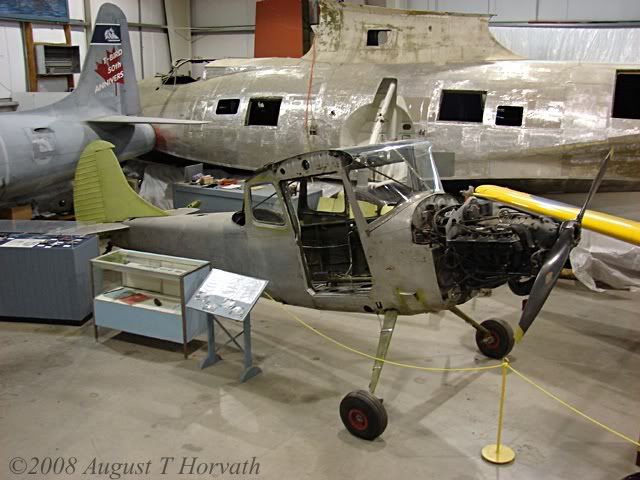
Harvard Mk.II 3840, with Canso tail, CF-5, and Ercoupe in background.
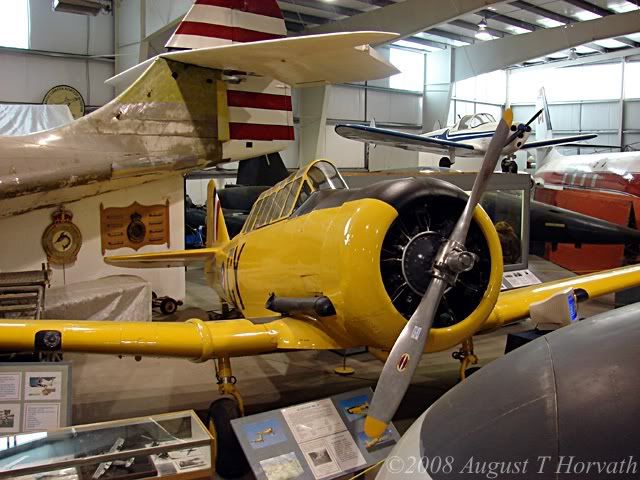
Tracker 12176.
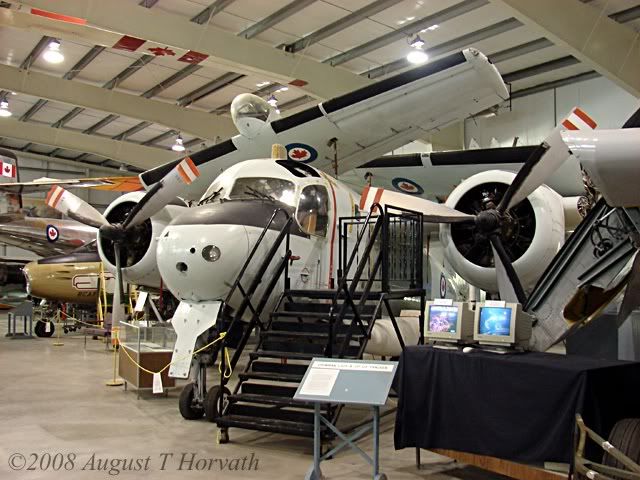
TBM ex-CF-ZYC Tanker 20, ex-USN 53607, wearing pseudo registration C-GFPL. This was recovered from a crash site and restored to tanker configuration to mark the role of Avengers in forest fire fighting in eastern Canada.
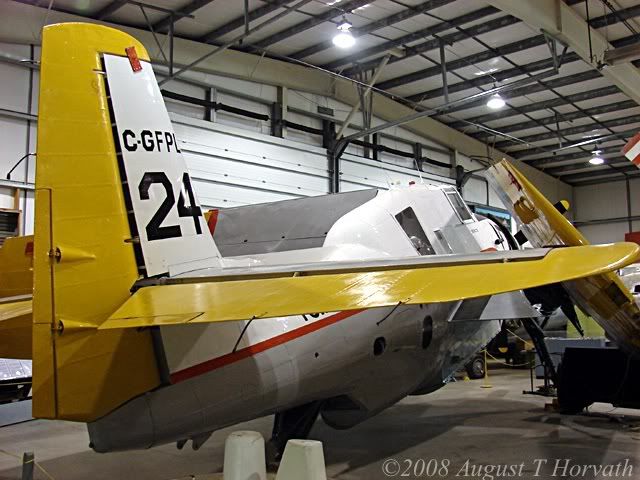
A great collection of aircraft, but in desperate need of more display space, even to display its current holdings, let alone when the Canso is completed. The volunteers clearly do the most with what they have.
My next stop, another 2 hours down the road near Dartmouth, across the harbor from Halifax, was the Shearwater Aviation Museum, dedicated primarily to Canadian Naval aircraft flown from its carriers and from the local Shearwater naval air base until the 1960s.
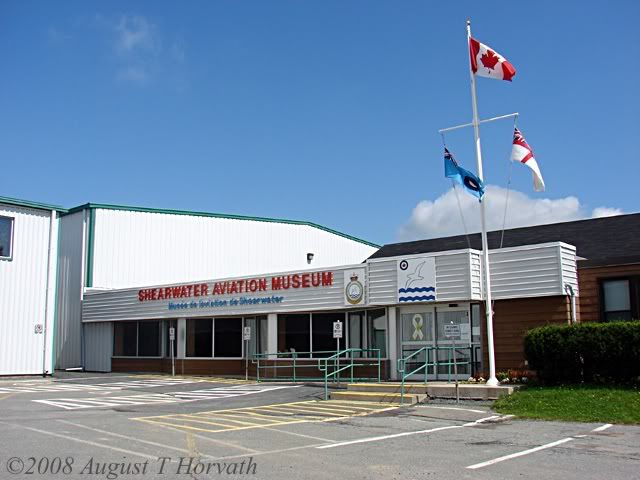
Aircraft are displayed in two exhibit galleries and an outdoor compound. Relative to the ACAM, there is much more indoor space for the exhibits, although that is at the expense of keeping some aircraft in the harsh seaside climate outside. A gem of the collection is its Fairey Swordfish, which was flown briefly in 1994 after its restoration.
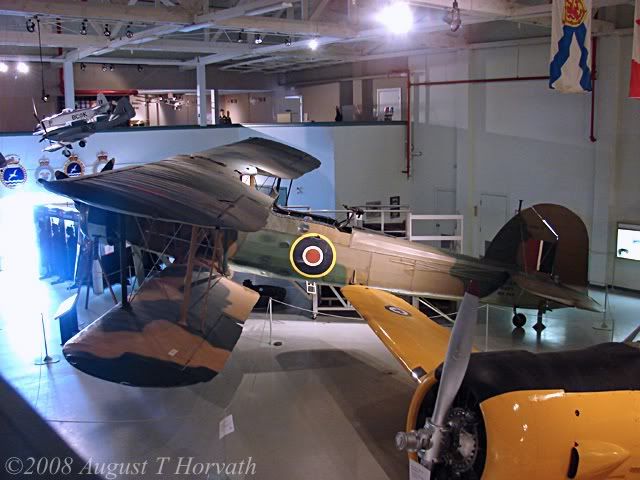
Next to it is Harvard Mk.II 2777 in 1950s RCN markings.
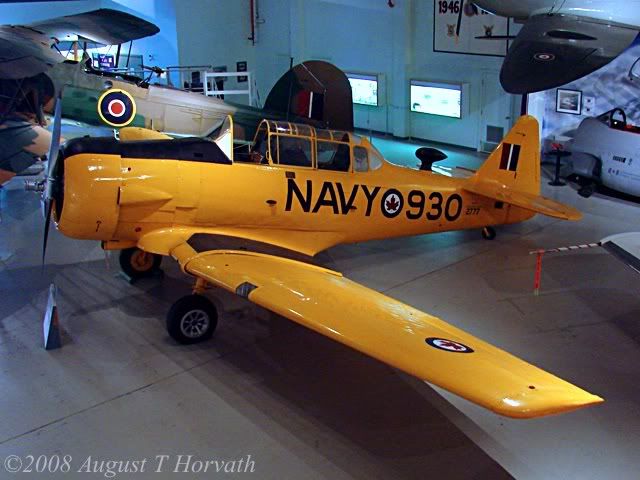
In the same gallery is Tutor 114075, formerly a Snowbirds machine.
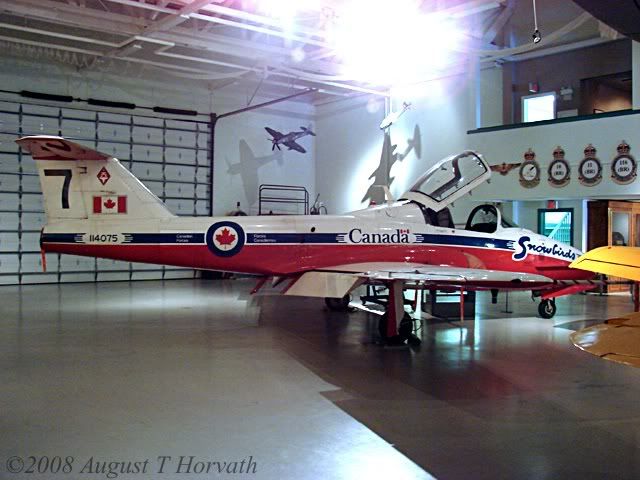
Most of the aircraft are displayed in the other, larger gallery. Tracker 1557:
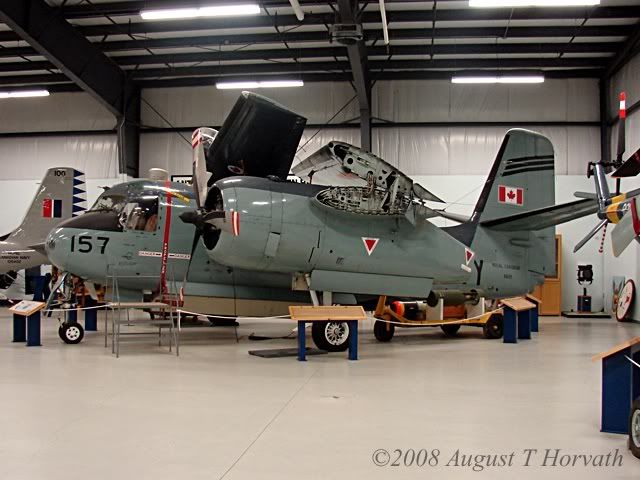
Sikorsky HO4S-3, ex-RCN 55885.
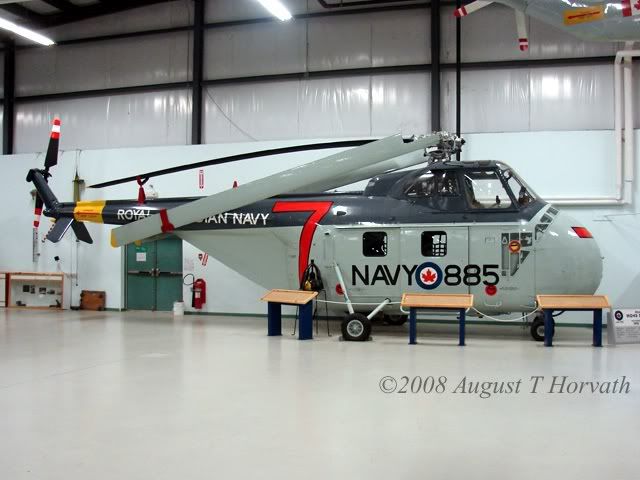
TBM 85861 was ditched near Halifax in 1957, recovered by Navy divers as a training exercise in 1972, and later placed on display. This aircraft is significant in being an ex-RCN machine that was never converted for civilian use, although it has had to be restored significantly.
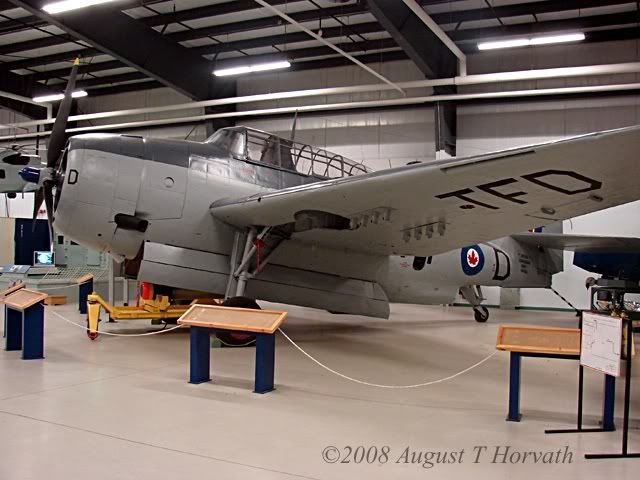
Closeup of canopy configuration typical of Canadian ASW Avengers.
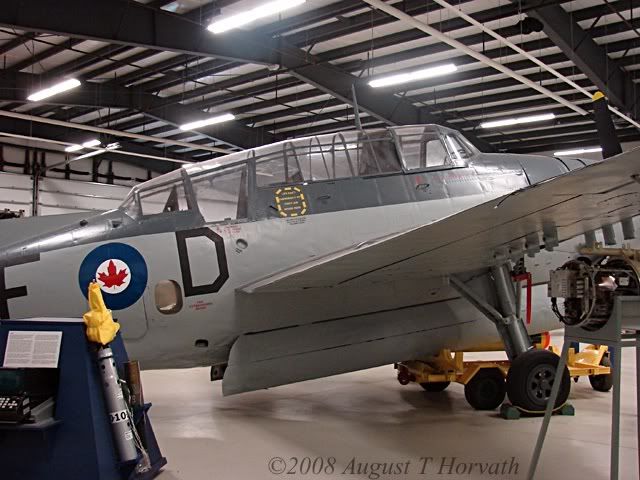
F2H Banshee 126402.

The museum's current marquee project, Fairey Firefly I PP462, ex-RCN and ex-Ethiopia, which like the Swordfish is intended to fly briefly after restoration.
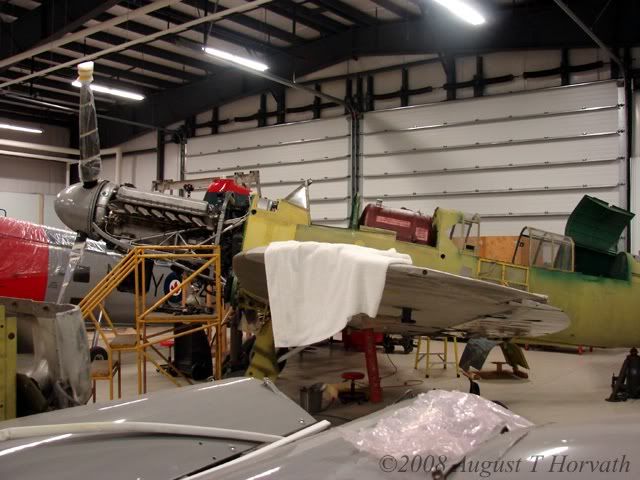
Now for the outside display area. T-33 133618. A second T-33 is under restoration indoors and is likely destined for RCN markings.
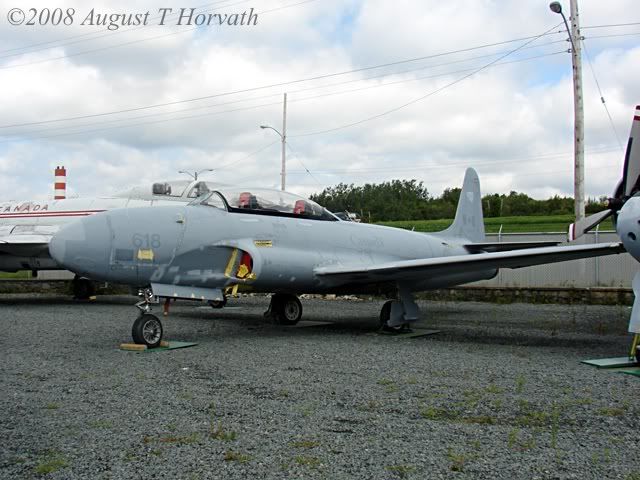
CF-5B 116832.
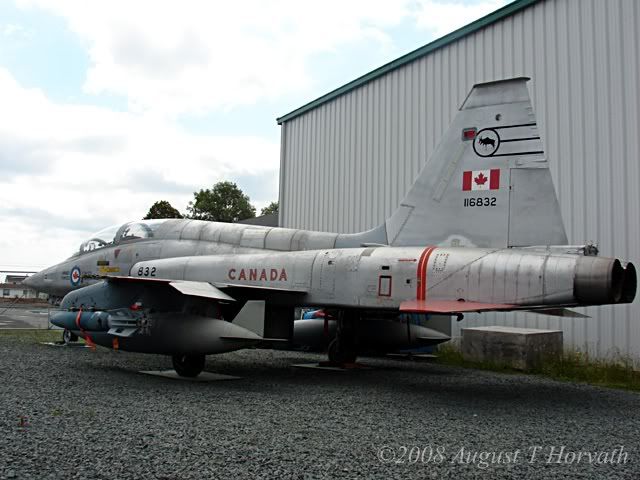
Tracker 1501. This machine is the first RCN Tracker, a pattern aircraft provided by Grumman to verify the Canadian production tooling.
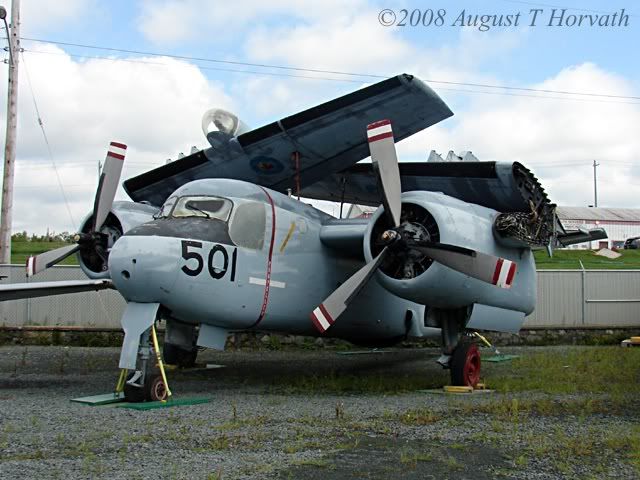
CF-101 101063.
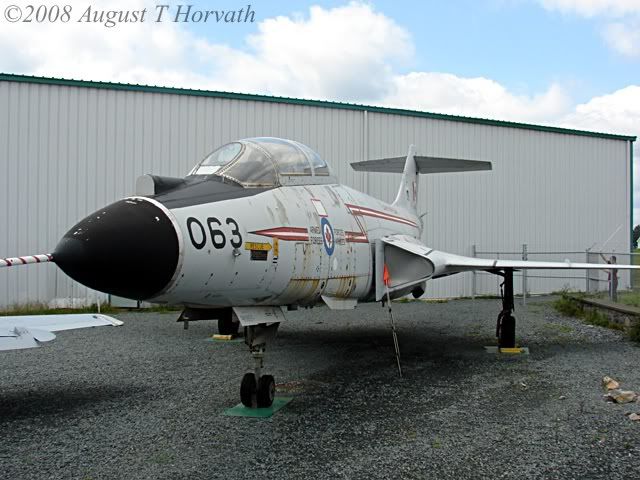
The local conditions are far from optimal for the preservation of aircraft on outdoor display.
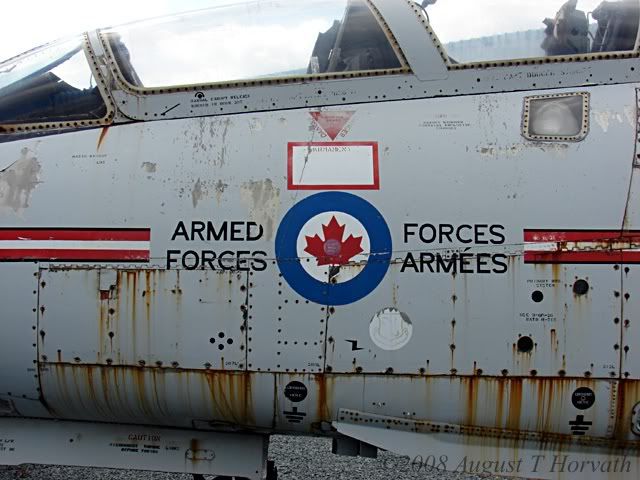
So, another fine collection. The restoration work was top notch, and the staff very friendly. They just need to get those outside aircraft under cover somehow -- same old story! But at least they're preserved, after a fashion.
Finally it was off to Greenwood, NS, another 2 hours down the road, to see the small but interesting collection at the base museum at CFB Greenwood. These aircraft are beautifully displayed on a grassy area outside, with no fences, next to a knoll from which one can get interesting topside shots of some of the aircraft. For me the highlight was another Lancaster, this time KB839.
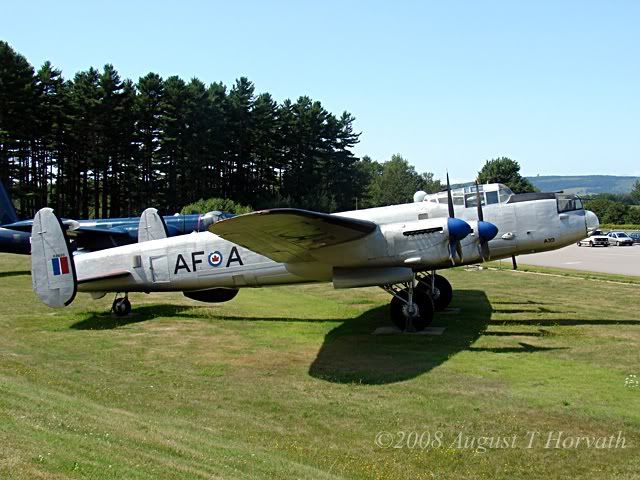
This is another 10AR modification, and also another combat veteran -- this time claiming 26 sorties and some battle damage while with 419 Sqn RCAF. In fact, this and the Edmundston Lanc are the only two surviving Canadian Lancs to have seen combat, and two of only four combat veteran Lancs in the world (the other two being R5868 at Hendon and W4783 at Canberra). However, some unfortunate things have been done during the restoration of this aircraft. A crude attempt was made to reverse superficially the 10AR modifications to convert her to an earlier patrol variant, with the antennas and sensors ripped off or painted over where this could be done easily, but otherwise left in place. The nose was made into a bizarre sort of turret mock-up, with gun barrels but no guns.
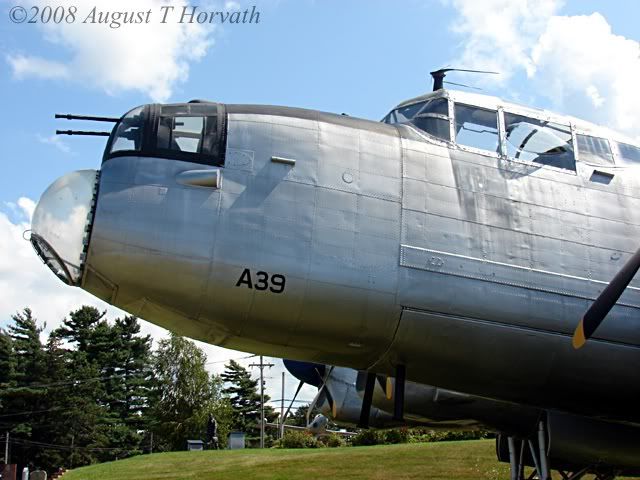
Other restoration shortcuts included the use of this truck tire to replace the tailwheel.
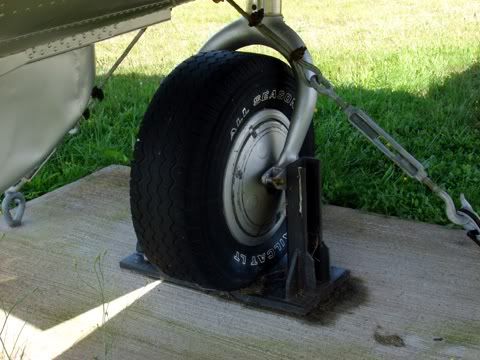
Despite that, it's a pretty airplane in beautiful surroundings.
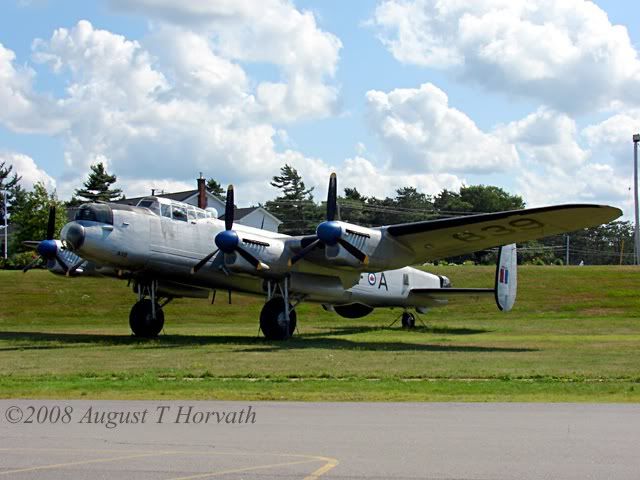
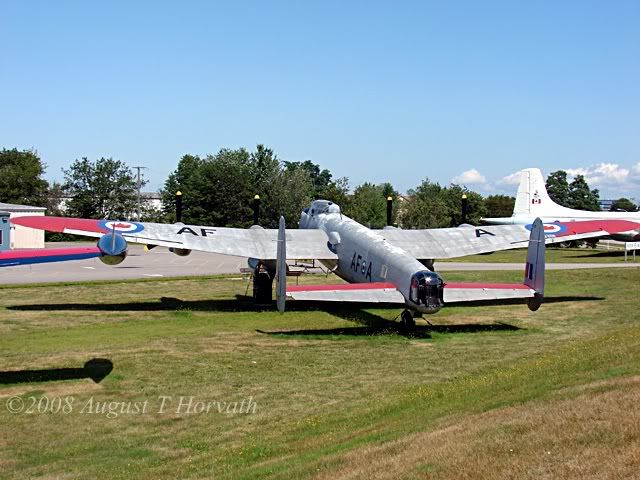
Of almost equal interest is a Lockheed Neptune, not actually an ex-RCN machine but USN 147969.
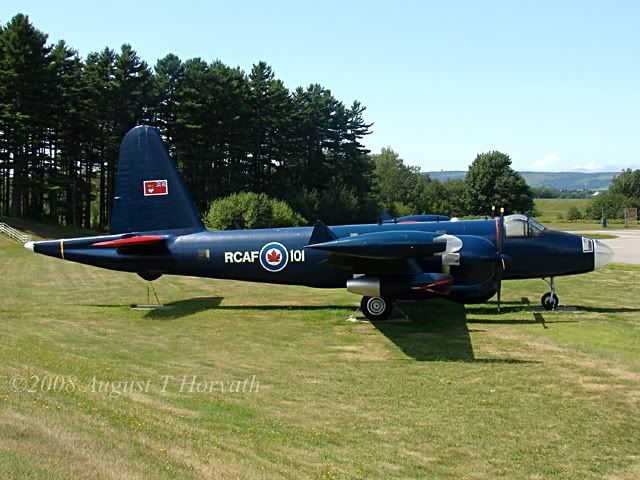
The museum itself (the blue part of the buildings in the background, on the right) can be seen in this photo.
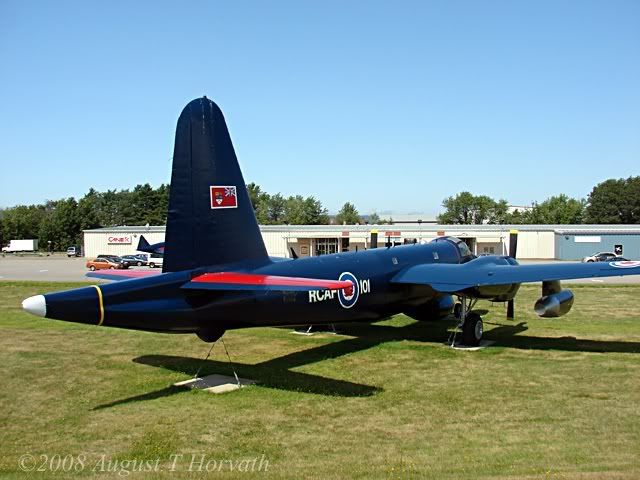
Across the driveway is a nicely preserved Argus, 20727.
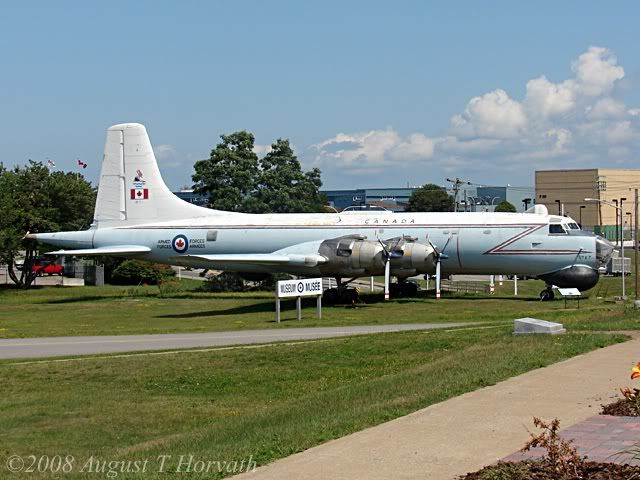
Next to the Argus, T-33 133393.
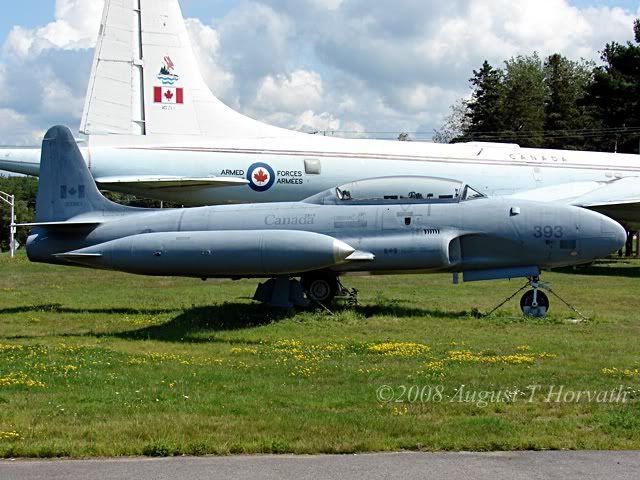
A second T-33 is displayed on a plinth across the road, 133434.
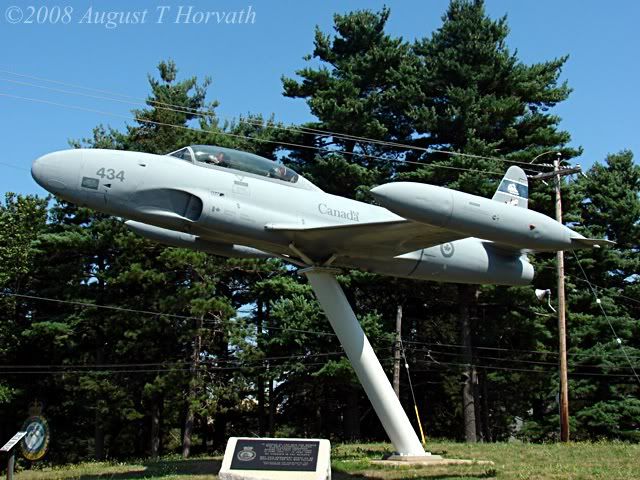
The museum has also acquired an Anson for restoration, but it was not on view. In the bushes behind the museum building are the nose and tail of Challenger VIP transport 144613.
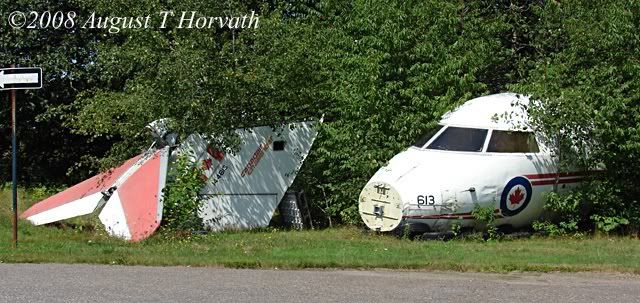
With all of these nice Canadian aircraft displayed together, I had a little fun with roundels.
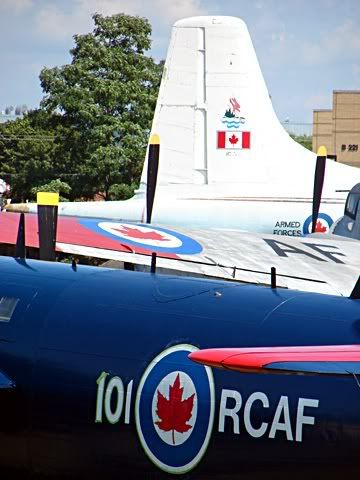
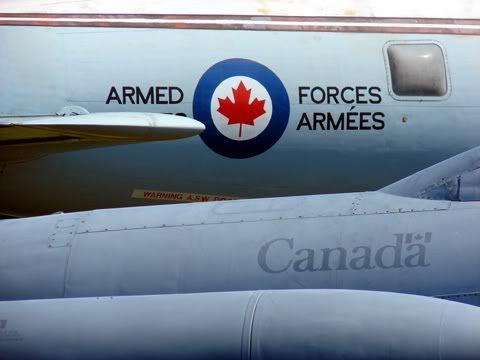
Another delightful collection and having done the entire Nova Scotia tour in one day, there was still time to return to New Brunswick and find accommodations near Fredericton before night fell. The next morning, I headed out to the airport to look for TBMs of Forest Protection Limited. Two were outside, Tanker 22 C-GFPL, missing an elevator:
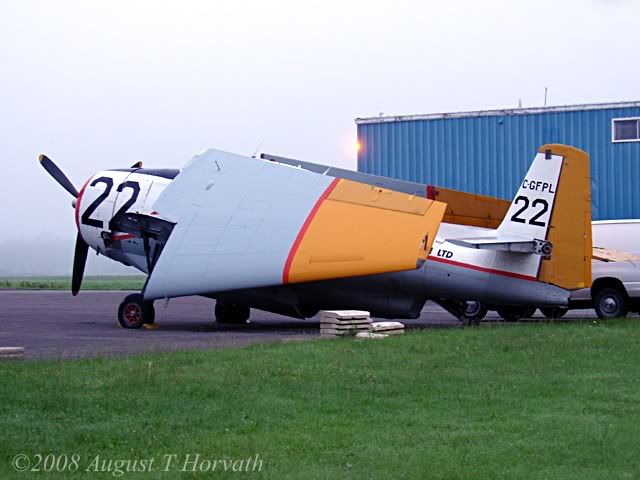
And this French registered aircraft:
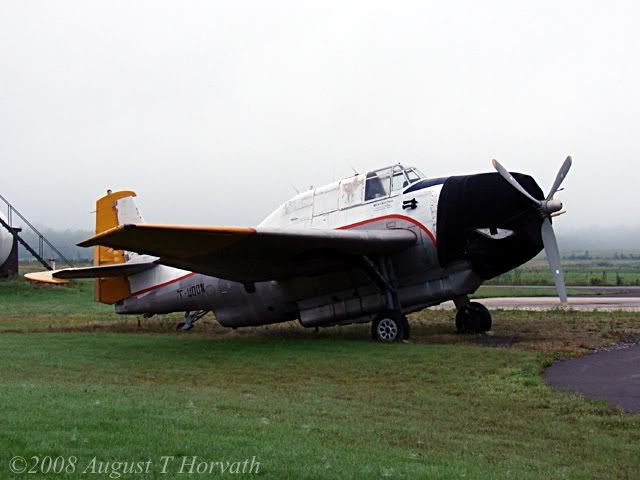
FPL maintains a few other TBMs, but they may have been in the hangar or, more likely, at FPL's remote base at Miramichi, this being the height of forest fire season in these parts. It being 6:30 a.m., there was nobody around to ask about it, and I needed to be on my way home.
Although that concludes the tour of the Canadian Maritimes, I did stop at the Owl's Head Transportation Museum in Rockland, Maine, on the way back, which may be of interest. This is a very nice but inaccessible facility that adds 2 hours, not counting visiting time, to anyone trying to blast through on I-95. But if you have not seen the collection, it is worth it. Probably the great gem of the collection is this Fokker F.IV:
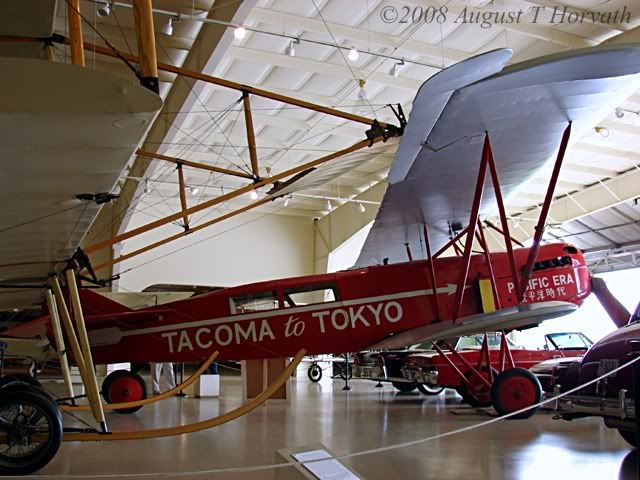
Originally built as a military recon aircraft, it was modified in Seattle to passenger configuration for a planned Tacoma to Tokyo flight that never quite worked out. A very rare aircraft, beautifully restored and airworthy. Alas, the view was somewhat obstructed by the presence of cars to be sold at an auto auction the next weekend, displayed in front of the aircraft.
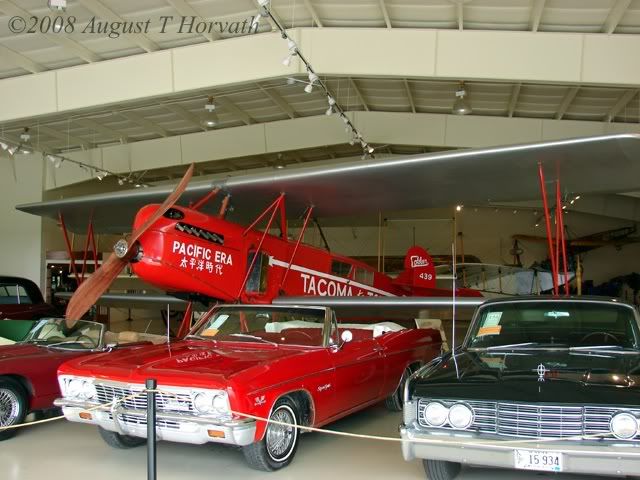
The museum boasts several fine airworthy pioneer and WWI replica aircraft, including this Taube:
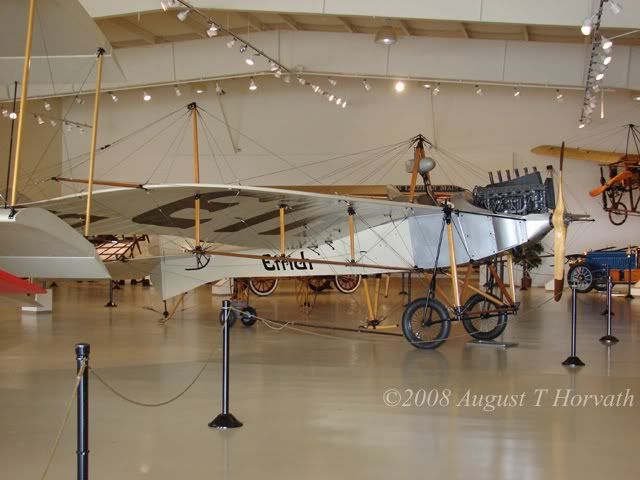
Sopwith Pup:
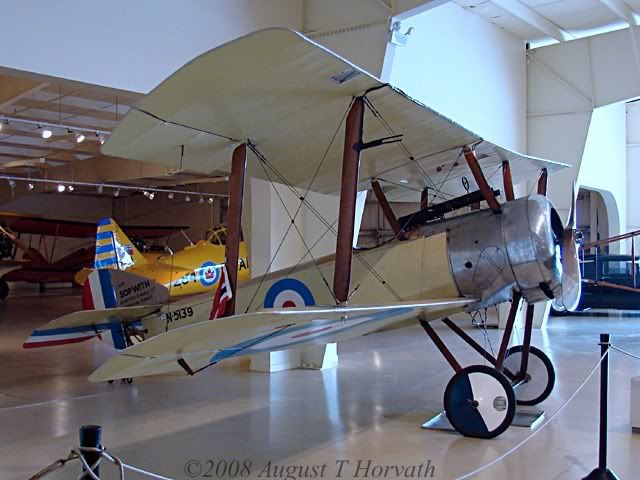
Beautiful Deperdussin replica:
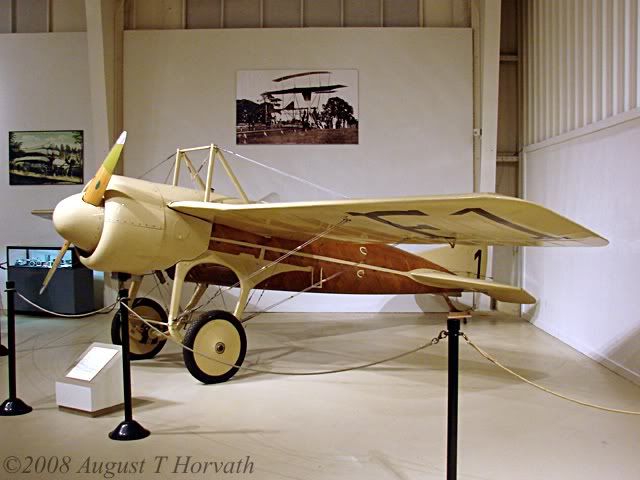
F.E.8:
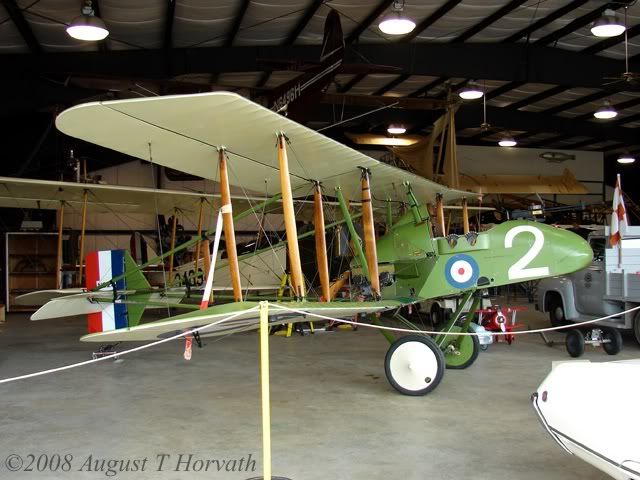
Stearman and Waco UBF-2:
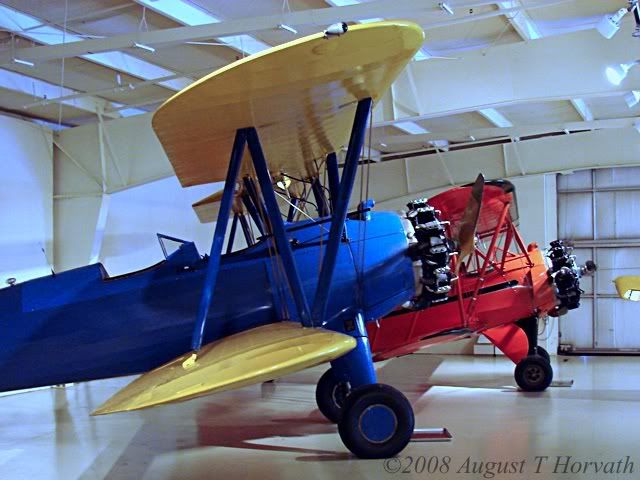
Tiger Moth:
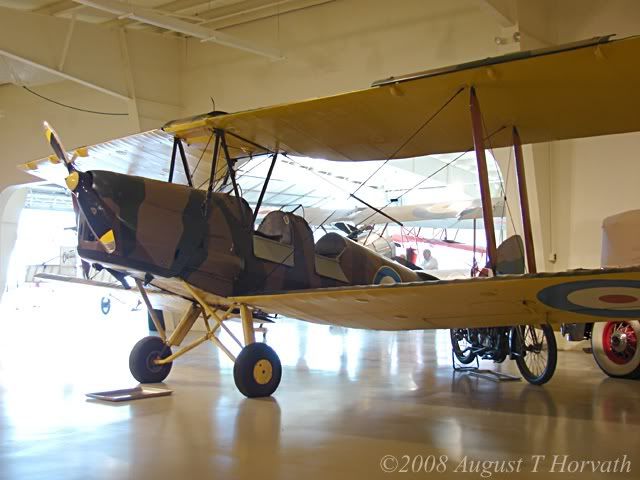
I didn't much care for most of the cars being readied for the auction, but I will cop to a certain attraction to this Auburn boattail.
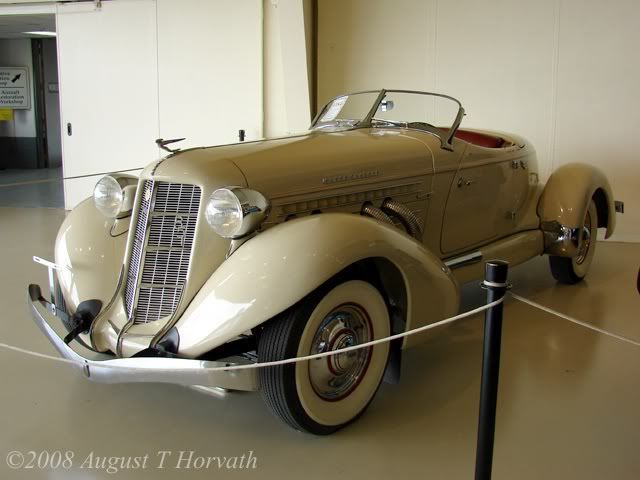
Not listed in the museum's catalog, and I guess a visitor to the premises, was Harvard Mk.IV 20284 N711SS:
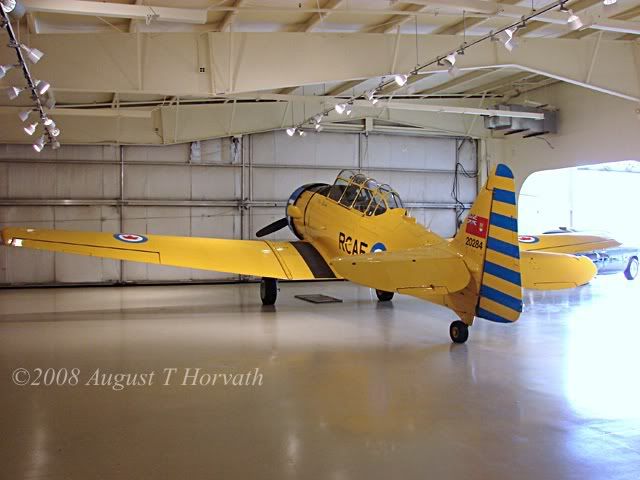
And another interesting visitor, Collings Foundation F4U-5NL 124692 N45NL.
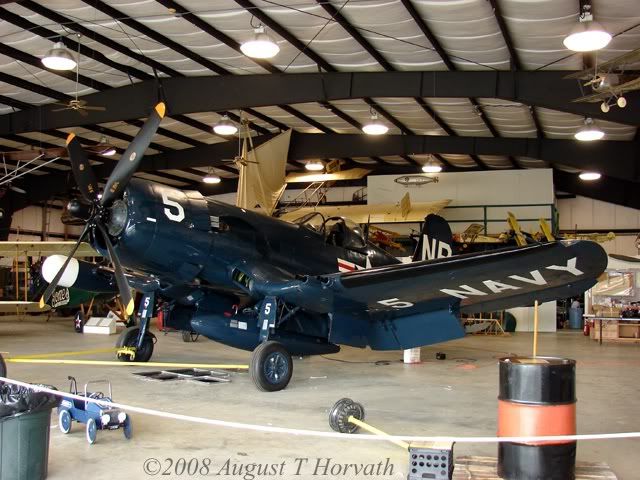
Another few hundred miles found me safely home, having covered over 2,300 miles for this little adventure. I think I will enjoy riding the train to work for a few days!
August

I decided to start by seeing one of the world's least-seen Avro Lancasters, Mk.10AR KB882 at Edmundston, NB. I drove direct from my house in a New York City suburb to Edmundston, a trip of some 660 miles, which took about 11 hours. Arriving around 8:00 local time, I then had to wait another hour for a thunderstorm to subside, and finally got to take some pics in the waning light.
Edmundston is a reasonably picturesque but foul-smelling logging and sawmill town very close to the border between New Brunswick and Quebec. It is served by a tiny one-runway airport that straddles the NB and Quebec border. The small building below serves the combined function of control "tower", passenger terminal, weather station, and all other administrative duties. It was unoccupied. In fact there was not another living soul on the airport, unless the geese who were enjoying the use of the runway have souls.

The few hangars were buttoned up tight and there were no other aircraft outside. KB882 sits in a clearing next to the administrative building next to a nice picnic area which would be a pleasant place to watch the air traffic if there were any. The aircraft itself is located barely on the NB side, about two wingspans from the "Bienvenue au Quebec" sign, next to a little stand of trees and with mountains in the background, quite nice really. Although the location is remote, both Trans Canada Highway 2 and the Trans Canada trail (a continuous 14,500-km hiking/biking trail that meanders through every Canadian province) are just meters away, so it does get seen by those with a wandering bent. One other tourist in an RV stopped to have a look while I was there.

The aircraft is surrounded by a chain link fence, but at only 4 feet high, it is easy to shoot over. Better yet, it has a gate which is not locked, so close-up inspection of the aircraft is possible. Despite the easy access and lack of supervision, there was no evidence of vandalism to the aircraft. Somebody obviously takes very good care of the aircraft.

KB882 is a bona fide veteran which, according to the placard, completed 15 ops over enemy territory with 428 Sqn RCAF. Returned to Canada for patrol duties, it was converted to 10AR photo recon configuration, which involved lengthening the nose by inserting a section forward of the windscreen and by installing an array of sensors and cameras. It was retired to this airport in 1964 and has been on outside display ever since.

Despite the long storage outside, the aircraft is in excellent condition, with good paint and very little evidence of corrosion. It has been preserved in stock 10AR configuration, with external and (so far as can be seen) internal equipment intact. It wears a generally accurate 1960s RCAF paint scheme but, oddly, no markings. Automatic spotlights illuminate the machine at night.

After looking around the aircraft I sought out the nearest place of lodging which appeared to have a decent restaurant attached, that being the Quality Inn Edmundston. I recommend this fine establishment if somehow you find yourself touring the area. The friendly bar clearly is popular with the locals, due no doubt to the excellent potato skins, regional beer, and my waitress, Frederique. In the morning I returned to the aircraft for a few dawn shots before proceeding to my business meetings on the coast.

The story picks up three days later when I set out to cover the Nova Scotia museums. The first and most easily reached is the Atlantic Canada Aviation Museum, which is located near the Halifax airport well outside of the city of Halifax on TCH-2. The premises are shared by a general purpose tourist information center, which must be useful for drawing a few incremental visitors to the museum.

Guarding the outside of the museum is CF-101 101043, which received a special paint scheme as "Lynx One" on the occasion of Voodoo retirement with 419 Sqn. Although repainted in 1999-2000, according to the museum's web site, it apparently is now being repainted again.

Inside, the exhibit space is crowded. Here, CF-104 104783 shares space with a Silver Dart replica, some helicopters, and assorted displays.

The main exhibit building is literally jam-packed with many interesting aircraft. Here, a Sabre Mk.V rests near CF-100 18747. The museum has a collection of RCAF/CAF jet fighters that is complete except for the early Vampire and the still-in-service CF-18.

T-33 133174 is displayed with wings off, there being no space to display the complete airplane.

Canadair Argus nose section.

L-19 Bird Dog project, ex US Army 56-4037 and RCAF 16720, with Canso project in background.

Harvard Mk.II 3840, with Canso tail, CF-5, and Ercoupe in background.

Tracker 12176.

TBM ex-CF-ZYC Tanker 20, ex-USN 53607, wearing pseudo registration C-GFPL. This was recovered from a crash site and restored to tanker configuration to mark the role of Avengers in forest fire fighting in eastern Canada.

A great collection of aircraft, but in desperate need of more display space, even to display its current holdings, let alone when the Canso is completed. The volunteers clearly do the most with what they have.
My next stop, another 2 hours down the road near Dartmouth, across the harbor from Halifax, was the Shearwater Aviation Museum, dedicated primarily to Canadian Naval aircraft flown from its carriers and from the local Shearwater naval air base until the 1960s.

Aircraft are displayed in two exhibit galleries and an outdoor compound. Relative to the ACAM, there is much more indoor space for the exhibits, although that is at the expense of keeping some aircraft in the harsh seaside climate outside. A gem of the collection is its Fairey Swordfish, which was flown briefly in 1994 after its restoration.

Next to it is Harvard Mk.II 2777 in 1950s RCN markings.

In the same gallery is Tutor 114075, formerly a Snowbirds machine.

Most of the aircraft are displayed in the other, larger gallery. Tracker 1557:

Sikorsky HO4S-3, ex-RCN 55885.

TBM 85861 was ditched near Halifax in 1957, recovered by Navy divers as a training exercise in 1972, and later placed on display. This aircraft is significant in being an ex-RCN machine that was never converted for civilian use, although it has had to be restored significantly.

Closeup of canopy configuration typical of Canadian ASW Avengers.

F2H Banshee 126402.

The museum's current marquee project, Fairey Firefly I PP462, ex-RCN and ex-Ethiopia, which like the Swordfish is intended to fly briefly after restoration.

Now for the outside display area. T-33 133618. A second T-33 is under restoration indoors and is likely destined for RCN markings.

CF-5B 116832.

Tracker 1501. This machine is the first RCN Tracker, a pattern aircraft provided by Grumman to verify the Canadian production tooling.

CF-101 101063.

The local conditions are far from optimal for the preservation of aircraft on outdoor display.

So, another fine collection. The restoration work was top notch, and the staff very friendly. They just need to get those outside aircraft under cover somehow -- same old story! But at least they're preserved, after a fashion.
Finally it was off to Greenwood, NS, another 2 hours down the road, to see the small but interesting collection at the base museum at CFB Greenwood. These aircraft are beautifully displayed on a grassy area outside, with no fences, next to a knoll from which one can get interesting topside shots of some of the aircraft. For me the highlight was another Lancaster, this time KB839.

This is another 10AR modification, and also another combat veteran -- this time claiming 26 sorties and some battle damage while with 419 Sqn RCAF. In fact, this and the Edmundston Lanc are the only two surviving Canadian Lancs to have seen combat, and two of only four combat veteran Lancs in the world (the other two being R5868 at Hendon and W4783 at Canberra). However, some unfortunate things have been done during the restoration of this aircraft. A crude attempt was made to reverse superficially the 10AR modifications to convert her to an earlier patrol variant, with the antennas and sensors ripped off or painted over where this could be done easily, but otherwise left in place. The nose was made into a bizarre sort of turret mock-up, with gun barrels but no guns.

Other restoration shortcuts included the use of this truck tire to replace the tailwheel.

Despite that, it's a pretty airplane in beautiful surroundings.


Of almost equal interest is a Lockheed Neptune, not actually an ex-RCN machine but USN 147969.

The museum itself (the blue part of the buildings in the background, on the right) can be seen in this photo.

Across the driveway is a nicely preserved Argus, 20727.

Next to the Argus, T-33 133393.

A second T-33 is displayed on a plinth across the road, 133434.

The museum has also acquired an Anson for restoration, but it was not on view. In the bushes behind the museum building are the nose and tail of Challenger VIP transport 144613.

With all of these nice Canadian aircraft displayed together, I had a little fun with roundels.


Another delightful collection and having done the entire Nova Scotia tour in one day, there was still time to return to New Brunswick and find accommodations near Fredericton before night fell. The next morning, I headed out to the airport to look for TBMs of Forest Protection Limited. Two were outside, Tanker 22 C-GFPL, missing an elevator:

And this French registered aircraft:

FPL maintains a few other TBMs, but they may have been in the hangar or, more likely, at FPL's remote base at Miramichi, this being the height of forest fire season in these parts. It being 6:30 a.m., there was nobody around to ask about it, and I needed to be on my way home.
Although that concludes the tour of the Canadian Maritimes, I did stop at the Owl's Head Transportation Museum in Rockland, Maine, on the way back, which may be of interest. This is a very nice but inaccessible facility that adds 2 hours, not counting visiting time, to anyone trying to blast through on I-95. But if you have not seen the collection, it is worth it. Probably the great gem of the collection is this Fokker F.IV:

Originally built as a military recon aircraft, it was modified in Seattle to passenger configuration for a planned Tacoma to Tokyo flight that never quite worked out. A very rare aircraft, beautifully restored and airworthy. Alas, the view was somewhat obstructed by the presence of cars to be sold at an auto auction the next weekend, displayed in front of the aircraft.

The museum boasts several fine airworthy pioneer and WWI replica aircraft, including this Taube:

Sopwith Pup:

Beautiful Deperdussin replica:

F.E.8:

Stearman and Waco UBF-2:

Tiger Moth:

I didn't much care for most of the cars being readied for the auction, but I will cop to a certain attraction to this Auburn boattail.

Not listed in the museum's catalog, and I guess a visitor to the premises, was Harvard Mk.IV 20284 N711SS:

And another interesting visitor, Collings Foundation F4U-5NL 124692 N45NL.

Another few hundred miles found me safely home, having covered over 2,300 miles for this little adventure. I think I will enjoy riding the train to work for a few days!
August
Sun Aug 17, 2008 6:37 pm
Nice work there August, thanks for the photos and the narritive was wonderful  I live to far to ever see a piece of a Lanc and you got to see two!! Is gas cheaper in the land of of the great white north? Compared to here?
I live to far to ever see a piece of a Lanc and you got to see two!! Is gas cheaper in the land of of the great white north? Compared to here?
Sun Aug 17, 2008 7:05 pm
Naw, it's more, and you can't buy a gallon of fuel there...ya gotta buy it by the leater...and ya gotta use funny money to boot! Loonies and toonies!!
Sun Aug 17, 2008 7:09 pm
I forgot to say, very nice pictures! That makes 4 Lancs that I know of in Canada now...
Sun Aug 17, 2008 7:16 pm
Interesting, August, I'll see if I can dig out some complimentary shots...
I'd be interested to know of anywhere in the first world where gas is cheaper than the US. As someone said, you don't know how lucky you are...
steve dickey wrote:Is gas cheaper in the land of of the great white north? Compared to here?
I'd be interested to know of anywhere in the first world where gas is cheaper than the US. As someone said, you don't know how lucky you are...
Sun Aug 17, 2008 7:26 pm
On Canadian Lancs: There are 7 displayed in Canada; I have had the good fortune to see FM104 (Toronto), FM212 (Windsor), FM213 (Hamilton), KB944 (Ottawa), and now KB839 and KB882. I still need to see FM136 (Calgary) and FM159 (Nanton); that will have to wait until I have some business pretext to be in Alberta and can do a Prairie Air Museum Tour to match this one.
On gasoline: It is still cheaper in the US, but the difference is less than I have ever seen it. It is too hard to convert litres to gallons, but I do know that it costs about C$90 to fill up my car in New Brunswick versus US$70 or so here, and the dollars are at parity these days. Before the recent run-up in US prices, it was quite a lot cheaper than in Canada even when the US dollar was worth substantially more than the Canadian.
August
On gasoline: It is still cheaper in the US, but the difference is less than I have ever seen it. It is too hard to convert litres to gallons, but I do know that it costs about C$90 to fill up my car in New Brunswick versus US$70 or so here, and the dollars are at parity these days. Before the recent run-up in US prices, it was quite a lot cheaper than in Canada even when the US dollar was worth substantially more than the Canadian.
August
Sun Aug 17, 2008 7:45 pm
it would sure be nice to see those combat vetran lancasters undercover and restored. very nice pics and a well written commentary to boot!! thanks for taking the time to share your adventure with all of us. oh, and i just couldnt resist; its spelled ; LITRES. 
Sun Aug 17, 2008 8:04 pm
These pics were taken in 2002/3
The Lockheed Hudson hulk outside the Halifax Atlantic Canada Aviation Museum. I wonder where it is now?

Given the Hudson is a very rare, very significant aircraft type (far more than any of the more common later Lockheed twins) it's a crying shame so few are on public display or safe inside. And there's only one flying. No criticism of the ACAM, as they are already over crowded, but it has to be one of the rarest and most important airframes they have - incomplete as it is.

The Shearwater Firefly. When I went it was on a secure area of CFB Shearwater, and you needed permission and escort to see it. Glad to see it's more accessible now, and I wonder how long to the first flight?
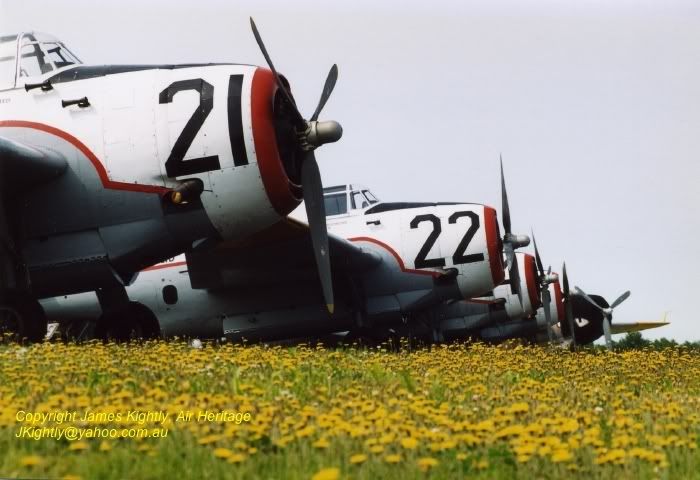
They were for sale when I called. The French one was there then, already sold. Interesting it's not moved.
And what made me go digging in the archives. The Greenwood Lanc is clearly being returned to 'wartime' configuration - not the changes in front and rear turrets between 2003 and 2008.


It's ironic that the two Canadian 'war veteran' Lancs are in the later schemes and (essentially) configurations and outside while the post-war non combat veteran Lancs are mostly inside and in wartime colours...
Thanks again, August.
The Lockheed Hudson hulk outside the Halifax Atlantic Canada Aviation Museum. I wonder where it is now?

Given the Hudson is a very rare, very significant aircraft type (far more than any of the more common later Lockheed twins) it's a crying shame so few are on public display or safe inside. And there's only one flying. No criticism of the ACAM, as they are already over crowded, but it has to be one of the rarest and most important airframes they have - incomplete as it is.

The Shearwater Firefly. When I went it was on a secure area of CFB Shearwater, and you needed permission and escort to see it. Glad to see it's more accessible now, and I wonder how long to the first flight?

They were for sale when I called. The French one was there then, already sold. Interesting it's not moved.
And what made me go digging in the archives. The Greenwood Lanc is clearly being returned to 'wartime' configuration - not the changes in front and rear turrets between 2003 and 2008.


It's ironic that the two Canadian 'war veteran' Lancs are in the later schemes and (essentially) configurations and outside while the post-war non combat veteran Lancs are mostly inside and in wartime colours...
Thanks again, August.
Sun Aug 17, 2008 8:10 pm
Thanks for the great pictures. Some extra info for you: The Forest Protection Operation at Fredericton has been closed up for several years. I've heard rumours that they are completely out of business, can anybody confirm this? The 2 Avengers you shot were in the same location, and the same general condition, in November 2006, when I was last there.
The Challenger pieces are left over from a crash at Shearwater in 1995. The aircraft did a serious bounce while practicing flapless landings, then one main gear collapsed at high speed on the subsequent touch down. Fortunately no one was seriously injured. More details on my web site
The Challenger pieces are left over from a crash at Shearwater in 1995. The aircraft did a serious bounce while practicing flapless landings, then one main gear collapsed at high speed on the subsequent touch down. Fortunately no one was seriously injured. More details on my web site
Sun Aug 17, 2008 8:17 pm
That's interesting, they were in full operation there when I visited in summer 2003, and moving onto using other types than the Avengers, but I don't think they were operating either type from there, it was a southern base, IIRC.Bill Walker wrote:Thanks for the great pictures. Some extra info for you: The Forest Protection Operation at Fredericton has been closed up for several years.
Bill - you have a question in the WOW thread.
Sun Aug 17, 2008 8:25 pm
I had a chance to visit the Lancs in Alberta....The one in Calgary...they recently built a cover for her....the Lanc in Nanton is inside....The staff there were very kind in letting me crawl inside of their bird...but was made to put on a helmet first....They saw me get off the little bus......
Sun Aug 17, 2008 8:32 pm
Thanks for the pics James. The Hudson may still be there; I didn't prowl around the grounds looking for it.
As for the Lancs, it hardly can be debated that they have not too many more years of outside display in them. I would just as soon see KB882 preserved as it is, a rare 10AR in good shape. KB839 I'm not sure what to say about. Here we have an airplane with 1 more sortie than the Memphis Belle and in every way as historic, but much less a cause celebre. It is too stripped to be a proper 10AR, probably could never really be converted back to a B.X, yet the turrets and especially the black framing suggest that we might see it in Bomber Command paint very soon. To become such a hybrid would be sad, but we can at least hope that it will continue to be preserved to somehow, someday be put right again.
August
As for the Lancs, it hardly can be debated that they have not too many more years of outside display in them. I would just as soon see KB882 preserved as it is, a rare 10AR in good shape. KB839 I'm not sure what to say about. Here we have an airplane with 1 more sortie than the Memphis Belle and in every way as historic, but much less a cause celebre. It is too stripped to be a proper 10AR, probably could never really be converted back to a B.X, yet the turrets and especially the black framing suggest that we might see it in Bomber Command paint very soon. To become such a hybrid would be sad, but we can at least hope that it will continue to be preserved to somehow, someday be put right again.
August
Sun Aug 17, 2008 8:33 pm
Calgary Lanc




Sun Aug 17, 2008 8:46 pm
k5083 wrote:As for the Lancs, it hardly can be debated that they have not too many more years of outside display in them. I would just as soon see KB882 preserved as it is, a rare 10AR in good shape. KB839 I'm not sure what to say about. Here we have an airplane with 1 more sortie than the Memphis Belle and in every way as historic, but much less a cause celebre. It is too stripped to be a proper 10AR, probably could never really be converted back to a B.X, yet the turrets and especially the black framing suggest that we might see it in Bomber Command paint very soon. To become such a hybrid would be sad, but we can at least hope that it will continue to be preserved to somehow, someday be put right again.
It is good that there are 'so many' Lancs preserved in Canada. But it is a pity that they are poorly distributed in terms of their own histories matching their colours - the example in the National collection 'should' be in maritime colours, IMHO, while I agree with you about KB882 - although it needs the full markings it seems!
It's easy to prescribe from a desk; and hard for individual organisations to achieve results to fit an idealistic national plan. Good on the Canadians for their many Lancaster achievements though!
Cheers
Sun Aug 17, 2008 8:55 pm
Indeed.
The Ottawa Lanc KB994 was someone unusual in having remained in essentially wartime configuration, including mid upper turret, until its retirement to the museum. Given that and the importance of the Lanc to Canadian war history, it is hard to take issue with it being in wartime config notwithstanding that it never saw ops. The pressure to return all of them to some semblance of WWII appearance is intense, memorialism trumping historical integrity as it so often does. We are fortunate to have so many on hand and to have supplied some to others (IWM and Kermit) although it is a tribute to the longevity of the type more than our own foresight.
August
The Ottawa Lanc KB994 was someone unusual in having remained in essentially wartime configuration, including mid upper turret, until its retirement to the museum. Given that and the importance of the Lanc to Canadian war history, it is hard to take issue with it being in wartime config notwithstanding that it never saw ops. The pressure to return all of them to some semblance of WWII appearance is intense, memorialism trumping historical integrity as it so often does. We are fortunate to have so many on hand and to have supplied some to others (IWM and Kermit) although it is a tribute to the longevity of the type more than our own foresight.
August